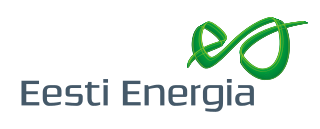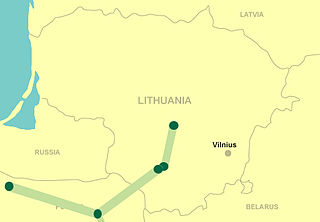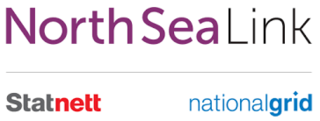
A high-voltage direct current (HVDC) electric power transmission system uses direct current (DC) for electric power transmission, in contrast with the more common alternating current (AC) transmission systems.

The Kontek HVDC is a 170-kilometre (110 mi) long, monopolar 400 kV high-voltage direct current cable between Germany and the Danish island Zealand. Its name comes from "continent" and the name of the former Danish power transmission company "Elkraft", which operated the power grid on the Danish islands Lolland, Falster and Zealand and had the abbreviation "ek". As of today, the cable is operated by Energinet.dk in Denmark and 50Hertz Transmission GmbH in Germany.

The Baltic Cable is a monopolar HVDC power line running beneath the Baltic Sea that interconnects the electric power grids of Germany and Sweden. Its maximum transmission power is 600 megawatts (MW).
SwePol is a 254.05-kilometre (157.86 mi)-long monopolar high-voltage direct current (HVDC) submarine cable between the Stärnö peninsula near Karlshamn, Sweden, and Bruskowo Wielkie, near Słupsk, Poland. The link was inaugurated in 2000 and can transmit up to 600 MW power at a voltage of 450 kV.

Fenno–Skan is the designation of the high voltage direct current transmission between Dannebo in Sweden and Rauma in Finland.
The HVDC Russia–Finland was a project to build a HVDC submarine power cable between Kernovo, Leningrad Oblast (Russia) and Mussalo, Kotka (Finland). The main purpose of this project was to export Russian nuclear energy to Sweden and Finland.
NordBalt is a submarine power cable between Klaipėda in Lithuania and Nybro in Sweden. The purpose of the cable is to facilitate the trading of power between the Baltic and Nordic electricity markets, and to increase the supply and energy security in both markets.

Eesti Energia AS is a public limited energy company in Estonia with its headquarters in Tallinn. It is the world's biggest oil shale to energy company. The company was founded in 1939. As of 2014, it operates in Estonia, Latvia, Lithuania, Finland, Jordan and Utah, United States. In Estonia, the company operates under the name Eesti Energia, while using the brand name Enefit for international operations. The main raw material for energy production – oil shale – is extracted from mines located in Eastern-Estonia and owned by the company. The group of Eesti Energia has three main operation areas: electricity generation, shale oil production, and sale and distribution of electricity. Its shares are owned by the Government of Estonia.

LitPol Link is an electricity link between Poland and Lithuania which connects the Baltic transmission system to the synchronous grid of Continental Europe. It has a capacity of 500 MW and since 2021 it can operate in a synchronous regime.

The synchronous grid of Continental Europe is the largest synchronous electrical grid in the world. It is interconnected as a single phase-locked 50 Hz mains frequency electricity grid that supplies over 400 million customers in 24 countries, including most of the European Union. In 2009, 667 GW of production capacity was connected to the grid, providing approximately 80 GW of operating reserve margin. The transmission system operators operating this grid formed the Union for the Coordination of Transmission of Electricity (UCTE), now part of the European Network of Transmission System Operators for Electricity (ENTSO-E).
The Vyborg HVDC scheme is a system of electricity transmission from the Russian power system to Finland, using high-voltage direct current. It consists of four 355 MVA (250 MW) back-to-back converter blocks, the first three of which were completed in the early 1980s and the last in January 2001. Much of the original converter equipment has been refurbished or modernised.
The Great Belt power link, also known as the Great Belt electricity link, is a high-voltage direct-current interconnection across the Great Belt between Funen and Zealand connecting two power transmission systems in Denmark.

Nord Pool AS is a pan-European power exchange. Nord Pool has a main office in Oslo and further offices in Stockholm, Helsinki, Tallinn and London. The company is owned by the European exchange operator Euronext as well as TSO Holding, which represents the continental Nordic and Baltic countries' transmission system operators. Nord Pool has two subsidiaries, Nord Pool AB and Nord Pool Finland Oy.

Elering AS is a national transmission system operator for electricity and natural gas with headquarters in Tallinn, Estonia. The managing director of Elering is Taavi Veskimägi.
The electricity sector in Finland relies on nuclear power, renewable energy, cogeneration and electricity import from neighboring countries. Finland has the highest per-capita electricity consumption in the EU. Co-generation of heat and electricity for industry process heat and district heating is common. Finland is one of the last countries in the world still burning peat.

The North Sea Link is a 1,400 MW high-voltage direct current submarine power cable between Norway and the United Kingdom.
Estonia's electricity sector is interconnected with regional energy markets, particularly through connections with Finland, Latvia, and Russia. The direct electrical interconnection with Finland was established in 2006 and was further strengthened by the Estlink 2 interconnector in 2014. Estonia joined the Nord Pool Spot market by 2012, securing its own price area within this regional electricity market.
The Kiisa Power Plant is an emergency reserve power plant, based on the engine power plant technology, located in Kiisa, Estonia, about 25 kilometres (16 mi) from Tallinn. As an emergency plant, it operates only in the case of a network failure or capacity shortfall, and it does not participate in the everyday electricity market. The power plant is owned and operated by the Estonian transmission system operator Elering.

The Nordic regional group of ENTSO-E is a synchronous electrical grid composed of the electricity grids of Norway, Sweden, Finland and the eastern part of electricity sector in Denmark. The grid is not synchronized with the Synchronous grid of Continental Europe, but has a number of non-synchronous DC connections with that as well as other synchronous grids. Gotland is not synchronized with the Swedish mainland either, as it is connected by HVDC.











